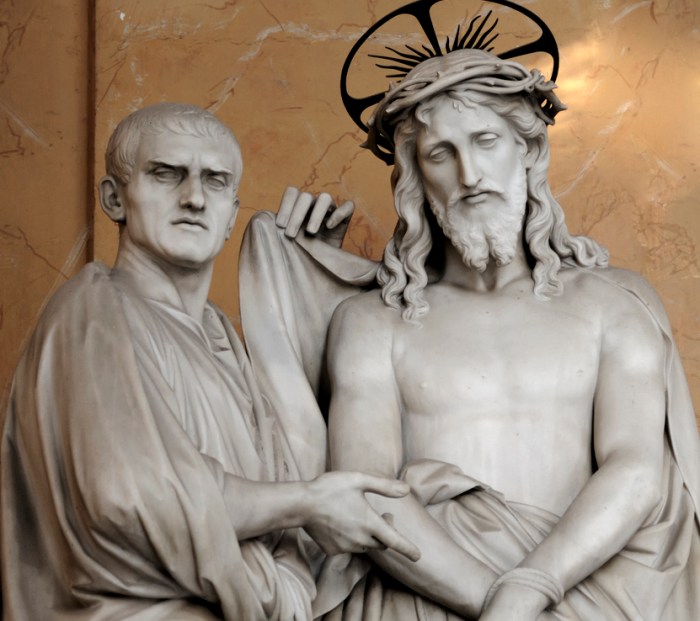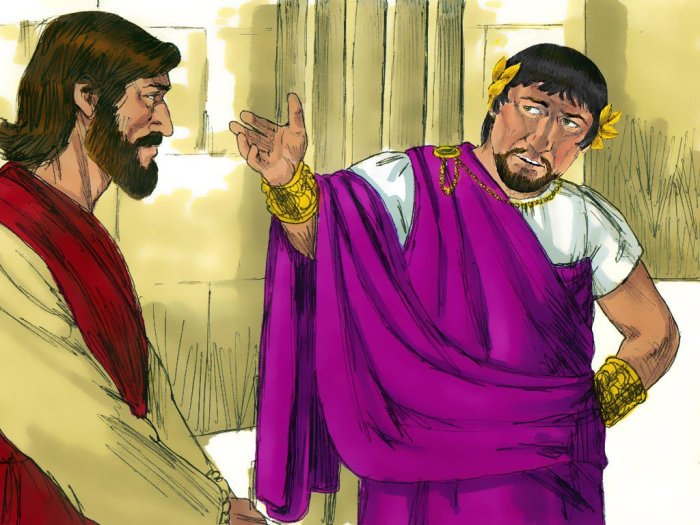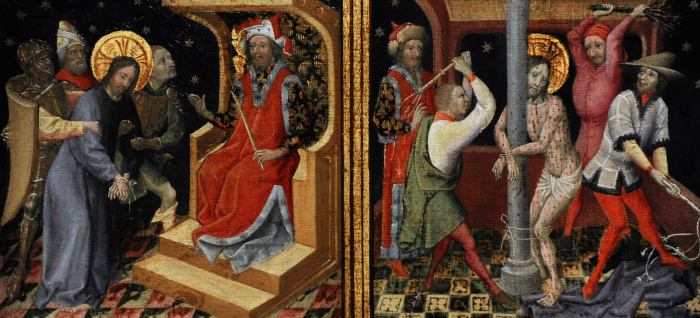Is Pontius Pilate in hell? This intriguing question has captivated theologians, historians, and artists for centuries. The story of Pilate, the Roman governor who presided over Jesus’ trial and crucifixion, is shrouded in mystery and speculation. In this article, we delve into the historical context, biblical perspectives, theological interpretations, and cultural depictions of Pontius Pilate to explore the enigma surrounding his afterlife.
Pilate’s role in the crucifixion of Jesus has been a subject of intense debate. Some believe he was a ruthless tyrant who willingly condemned an innocent man to death. Others argue that he was a reluctant participant, pressured by the Jewish authorities and the threat of a riot.
Historical Context

Pontius Pilate’s governorship of Judea from 26 to 36 CE was a turbulent period marked by religious tensions and political unrest. The Jewish population, particularly the religious leaders, held strong beliefs and customs that often clashed with Roman authority.
Pilate’s interactions with the Jewish authorities were frequently strained. He faced constant pressure to maintain order and quell any potential disturbances that could threaten Roman control over the province.
Pilate’s Interactions with the Jewish Authorities
Pilate’s actions, such as introducing Roman standards with images of the emperor into Jerusalem and using temple funds for an aqueduct project, often sparked outrage among the Jewish population. These actions were seen as disrespectful and insensitive to Jewish religious beliefs and traditions.
Biblical Perspectives

The Bible provides detailed accounts of Pontius Pilate’s involvement in the trial and execution of Jesus Christ. These accounts offer insights into Pilate’s character, motivations, and the political and religious context of the events.
Pilate’s Involvement in Jesus’ Trial
According to the Gospels, Pilate was the Roman governor of Judea when Jesus was arrested and brought before him for trial. The Jewish leaders accused Jesus of blasphemy and sedition, but Pilate found no fault in him. However, under pressure from the crowd and the threat of a riot, Pilate reluctantly sentenced Jesus to crucifixion.
Pilate’s Character and Motivations
The Gospels portray Pilate as a complex and conflicted character. He is initially reluctant to condemn Jesus, but ultimately yields to the demands of the crowd. Some scholars argue that Pilate was primarily motivated by political expediency, while others suggest that he was influenced by a sense of justice and compassion for Jesus.
Is Pontius Pilate in hell? That’s a question for the ages. But let’s take a break from pondering the afterlife and talk about something more pressing: the Delta Sigma Pi final exam . Good luck to all the candidates! Now, back to our original question: is Pontius Pilate in hell? We may never know for sure, but it’s certainly a fascinating topic to ponder.
Theological Interpretations

Theological interpretations of Pontius Pilate’s fate after death vary widely. Some believe he descended into Hell, while others suggest he ascended to Heaven or entered Purgatory.
Beliefs about Pilate’s Location in the Afterlife
Various Christian denominations and theological perspectives hold differing beliefs about Pilate’s afterlife destination:
- Hell:According to some traditions, Pilate is believed to have suffered eternal torment in Hell for his role in Jesus’ crucifixion.
- Heaven:Some Christian sects, such as the Coptic Orthodox Church, believe Pilate repented and converted to Christianity, earning him a place in Heaven.
- Purgatory:In Catholic theology, Purgatory is a state of purification for those who died in a state of grace but still have venial sins to be cleansed. Some theologians suggest Pilate may have spent time in Purgatory before entering Heaven.
Cultural Depictions

Pilate’s character has been a subject of fascination and interpretation across cultures, finding expression in various forms of art, literature, and popular culture.
In Western art, Pilate is often depicted as a hesitant and conflicted figure, torn between his duty to Rome and his conscience. In literature, he has been portrayed as a tragic hero, a victim of circumstance, or even a villain.
In popular culture, he has been referenced in countless works of fiction, film, and television, often as a symbol of authority or the complexities of justice.
Art, Is pontius pilate in hell
- In Michelangelo’s famous fresco in the Sistine Chapel, Pilate is shown washing his hands, a gesture symbolizing his unwillingness to take responsibility for Jesus’ death.
- In Rembrandt’s painting “Ecce Homo,” Pilate presents Jesus to the crowd, highlighting the tension between the two figures.
- In modern art, Pilate has been depicted in various styles, including abstract expressionism and pop art, reflecting the changing cultural perceptions of his character.
Literature
- In the Gospels, Pilate is portrayed as a reluctant judge who ultimately yields to the pressure of the Jewish leaders to crucify Jesus.
- In the novel “The Master and Margarita” by Mikhail Bulgakov, Pilate is depicted as a complex and sympathetic character who is haunted by his decision to execute Jesus.
- In the play “Pilate” by Frank Moorhouse, Pilate is presented as a man who is torn between his loyalty to Rome and his own moral conscience.
Popular Culture
- In the film “The Passion of the Christ” (2004), Pilate is portrayed as a ruthless and ambitious politician who is eager to please the crowd.
- In the television series “The Bible” (2013), Pilate is depicted as a more sympathetic character who is genuinely torn about his decision to crucify Jesus.
- In the video game “Assassin’s Creed,” Pilate is featured as a historical figure who is involved in the events leading up to Jesus’ death.
Archaeological Evidence: Is Pontius Pilate In Hell

Archaeological evidence provides valuable insights into the existence of Pontius Pilate and his role in the crucifixion of Jesus.
One significant discovery is the Pilate Stone, a limestone fragment unearthed in Caesarea Maritima in 1961. This inscription bears Pilate’s name and title, “Prefect of Judea,” confirming his governorship during the time of Jesus’ crucifixion.
Pilate’s Ring
Another archaeological find is Pilate’s ring, discovered in 1917 at the Herodian palace in Jerusalem. The ring bears the inscription “Pilatus,” further supporting his presence in Judea during the Roman occupation.
Caesarea Maritima Aqueduct
The Caesarea Maritima Aqueduct, built under Pilate’s rule, is an impressive engineering feat that transported water to the coastal city of Caesarea. This aqueduct serves as physical evidence of Pilate’s administrative and infrastructural initiatives during his governorship.
FAQ Summary
Did Pontius Pilate convert to Christianity?
There is no historical evidence to support this claim.
Was Pontius Pilate a cruel and heartless governor?
Historical accounts depict Pilate as a harsh and ambitious politician, but there is no consensus on his personal character.
Is there any archaeological evidence that confirms Pontius Pilate’s existence?
Yes, the Pilate Stone, discovered in 1961, provides archaeological evidence of Pilate’s governorship in Judea.